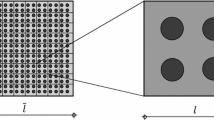Abstract
The paper offers a new anisotropic closure model for equations of Lagrangian gas dynamics and elastoplastic in mixed cells containing several components (materials). The model is realized in the EGAK code; and numerical investigations of a method on test problems are conducted. The paper presents full statements of two one-dimensional problems and one two-dimensional problem, as well as a description of the processing technique for the results. The numerical results are compared with the results obtained by another closure model available in the EGAK code and with the analytical solutions. The analysis and discussion of the computational results are presented.
Similar content being viewed by others
References
R. Tipton, “CALE mixed zone pressure relaxation,” private commun. (Lawrence Livermore Natl. Laboratory, 1989).
D. Miller and G. Zimmerman, “An algorithm for time evolving volume fractions in mixed zones in lagrangian hydrodynamics calculations,” Report UCRL-PRES-223908 (Lawrence Livermore Natl. Laboratory, 2006).
M. Baer and J. Nunziato, “A two-phase mixture theory for the deflagration-to-detonation transition (ddt) in reactive granular materials,” Int. J. Multiphase Flow 12, 861–889 (1986).
A. Murrone and H. Guillard, “A five equation reduced model for compressible two phase flow problems,” J. Comput. Phys. 202, 664–698 (2005).
J. Kamm, M. Shashkov, J. Fung, A. Harrison, and T. Canfield, “A comparative study of various pressure relaxation closure models for one-dimensional two-material lagrangian hydrodynamics,” Int. J. Numer. Meth. Fluids 65, 1311–1324 (2010).
M. Shashkov, “Closure models for multimaterial cells in arbitrary lagrangian-eulerian hydrocodes,” Int. J. Numer. Meth. Fluids 56, 1497–1504 (2007).
M. Francois, M. Shashkov, E. Dendy, and R. Lowrie, “Mixture models for multimaterial eulerian and lagrangian hydrocodes,” Report LAUR-10-03391 (Los Alamos Natl. Laboratory, 2010).
Y. Yanilkin, E. Goncharov, V. Kolobyanin, V. Sadchikov, J. Kamm, M. Shashkov, and W. Rider, “Multi-material pressure relaxation methods for lagrangian hydrodynamics,” Comput. Fluids 83, 137–143 (2013).
Y. Bondarenko and Y. Yanilkin, “Computation of the thermodynamic parameters in the mixed cells in gas dynamics,” Math. Model. 14, 63–81 (2002).
V. I. Delov and V. V. Sadchikov, “Comparison of some models for calculation of thermodynamic parameters of lagrange cells with inhomogeneous composition,” Vopr. At. Nauki Tekh., Ser.: Mat. Model. Fiz. Protsessov, No. 1, 57–70 (2005).
E. A. Goncharov and Yu. V. Yanilkin, “The new computational method for thermodynamic state of materials in mixed cells,” Vopr. At. Nauki Tekh., Ser.: Mat. Model. Fiz. Protsessov, No. 3, 16–30 (2004).
A. Barlow, “A new lagrangian scheme for multimaterial cells,” in Proceedings of European Congress on Computational Methods in Applied Sciences and Engineering, ECCOMAS Computational Fluid Dynamics Conference, Swansea–Wales, UK, 2001, pp. 235–294.
A. Despres and F. Lagoutiere, “Numerical solution of two-component compressible fluid model with interfaces,” Prog. Comput. Fluid Dyn. 7, 295–310 (2007).
R. Hill, A. Barlow, and M. Shashkov, “Interface-aware sub-scale dynamics closure model,” Report LAUR-12-21959 (Loughborough, UK, 2012).
J. W. Grove, “Pressure-velocity equilibrium hydrodynamic models,” Acta Math. Sci. B 30, 563–594 (2010).
S. M. Bakhrakh, V. P. Spiridonov, and A. A. Shanin, “A method for heterogeneous medium gas-dynamic flow computations in lagrangian-eulerian coordinates,” Dokl. Akad. Nauk SSSR 276 (4) (1984).
F. H. Harlow, “The particle-in-cell method for numerical solution of problems in fluid dynamics,” Proc. Symp. Appl. Math. 15, 269(1963).
E. A. Goncharov, V. Yu. Kolobyanin, and Yu. V. Yanilkin, “Closure method of lagrangian gas dynamics in mixed cells based on the equality of component velocities,” Vopr. At. Nauki Tekh., Ser.: Mat. Model. Fiz. Protsessov, No. 4, 100–105 (2006).
A. Barlow, R. Hill, and M. Shashkov, “Constrained optimization framework for interface-aware sub-scale dynamics closure model for multimaterial cells in lagrangian and arbitrary lagrangian-eulerian hydrodynamics,” J. Comput. Phys. 276, 92–135 (2014).
Yu. V. Yanilkin, S. P. Belyaev, Yu. A. Bondarenko, et al., “Eulerian numerical methods EGAK and TREK for simulation of multidimensional flows of multicomponent media,” Tr. RFIATS-VNIIEF, No. 12, 54–65 (2008).
E. A. Goncharov, Yu. V. Yanilkin, and V. Yu. Kolobyanin, “On the determination of artificial viscosity for mixed cell compoonents,” Vopr. At. Nauki Tekh., Ser.: Mat. Model. Fiz. Protsessov, No. 2, 15–29 (2010).
Yu. Yanilkin et al., “Study and implementation of multi-material pressure relaxation methods for lagrangian hydrodynamics,” Report under Task Order 039, LANS/VNIIEF Agreement No. 37713-000-02-35, Deliverable 5.2 (LANS, 2010).
Yu. Yanilkin et al., “Study and implementation of multi-material pressure relaxation methods for lagrangian hydrodynamics,” Report under Task Order 039, LANS/VNIIEF Agreement No. 37713-000-02-35, Deliverable 5.3 (LANS, 2011).
Mathematical Simulation of Turbulent Mixing in Compressible Media, Course of Lectures, Ed. by Yu. V. Yanilkin, V. P. Statsenko, and V. I. Kozlov (FGUP RFIATS-VNIIEF, Sarov, 2009) [in Russian].
EGIDA-2D Code for 2D Problems Simulation, The School-Book, Ed. by Yu. V. Yanilkin (FGUP RFIATSVNIIEF, Sarov, 2008), Vol. 1 [in Russian].
A. A. Kraiukhin, V. A. Svidinskii, A. L. Stadnik, and Yu. V. Yanilkin, “Nonstationary problems for testing elastoplasticity codes,” Vopr. At. Nauki Tekh., Ser.: Mat. Model. Fiz. Protsessov, No. 2, 17–30 (2016).
R. Saurel and R. Abgrall, “A multiphase Godunov method for compressible multifluid and multiphase flows,” J. Comput. Phys. 150, 425–467 (1999).
B. Plohr, “Shockless acceleration of thin plates modeled by a tracled random choice method,” AIAA J. 26, 470–478 (1988).
G. Sod, “A survey of several finite difference methods for systems of nonlinear hyperbolic conservation laws,” J. Comput. Phys. 27, 1–31 (1978).
Author information
Authors and Affiliations
Corresponding author
Additional information
Original Russian Text © Y.V. Yanilkin, O.O. Toporova, V.Yu. Kolobyanin, 2017, published in Matematicheskoe Modelirovanie, 2017, Vol. 29, No. 8, pp. 44–58.
Rights and permissions
About this article
Cite this article
Yanilkin, Y.V., Toporova, O.O. & Kolobyanin, V.Y. Anisotropic Closure Model in Mixed Cells. Math Models Comput Simul 10, 164–175 (2018). https://doi.org/10.1134/S207004821802014X
Received:
Published:
Issue Date:
DOI: https://doi.org/10.1134/S207004821802014X




